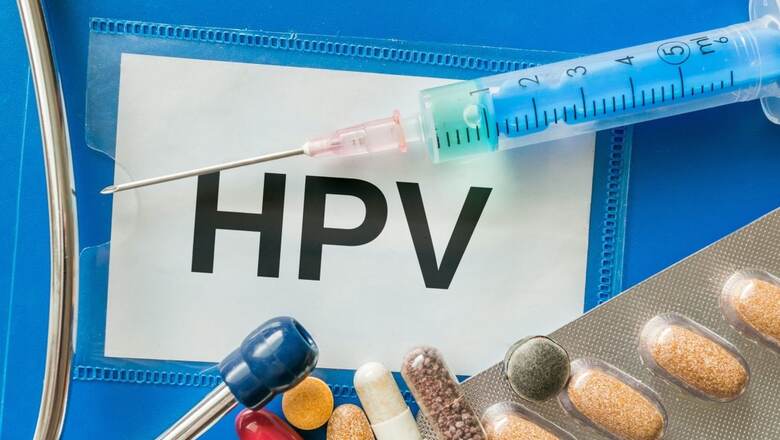
views
As a mother of a nine-year-old daughter and a physician myself, I was one of the first in line to get the HPV vaccine shot when it was first made available in India in 2014. We got three doses each. The latest vaccines offer close to 100 per cent protection with a single shot. And as always, India makes available a highly effective, made-at-home HPV vaccine — Cervavax — at an astonishingly low price. We will roll it out for free in our universal immunisation program soon, with the largest coverage in the world. The urgency of the move is amplified in view of India bearing one of the highest burdens of cervical cancer globally, with the load falling majorly on the poor, lacking health coverage and financial resources for treatment.
A decade back, when I got my daughter and myself vaccinated, scepticism for the efficacy and safety of the HPV vaccine was high, even among my physician colleagues. Today, multiple clinical trials across many countries have proved that the latest HPV vaccines are very safe with close to perfect efficacy at preventing HPV infection and related diseases.
25 million women among 500 million-plus women in India harbour Human Papilloma Virus (HPV) 16/18 infection, the cause of 83.2 per cent of invasive cervical cancers. HPV transmits sexually, enters inside human cells, and damages their DNA, leading to changes that may result in cancer. HPV is thought to be responsible for more than 90 per cent of anal and cervical cancers, about 70 per cent of vaginal and vulvar cancers, and more than 60 per cent of penile cancers. Oropharyngeal cancers may also be linked to HPV.
Men are susceptible, too, and need HPV vaccine coverage for the prevention of HPV-related genital warts and carcinomas. Also, by getting vaccinated, men lower the chance of passing on the virus to their partners, who may develop cervical, vaginal, vulvar, or anal cancer from HPV.
Six in 10 women with HPV-related cancers succumb. The low coverage of screening — just two in a hundred women — and vaccination, coupled with the high burden of poverty and social stigma, contribute to the high mortality rate of cervical cancer in India. This is when this cancer is fully preventable! And it can be eliminated within our lifetime.
Cervical cancer is the only cancer that can be eliminated in a short time by seamlessly integrating vaccination, screening, and treatment. Imagine 660,000 living, breathing, thriving young women and their families across the world, and envision the power of freeing them from the scourge of cervical cancer once and for all! HPV vaccines potentially make such an impactful abolition a reality in the near future.
The World Health Organisation (WHO) has set ambitious targets for eliminating cervical cancer by 2030, which include vaccinating 90 per cent of girls with the HPV vaccine by the age of 15, screening 70 per cent of women with a high-performance test by 35 and 45 years of age, and treating 90 per cent of women with precancerous lesions or invasive cancer. Achieving these targets would require a coordinated and comprehensive approach that involves strengthening the health system, increasing awareness and demand, improving access and affordability, and ensuring quality and equity. India can potentially become a global leader in cervical cancer elimination if we can overcome the challenges and seize the opportunities. Let us see how.
Immunise the daughters and screen the moms: The definitive key to cervical cancer elimination
Cervical cancer is to cancers like Polio is to infectious diseases — completely eliminable through the simple but powerful agency of vaccines. Fortuitously for India, host to a fifth of cervical cancer globally, a safe indigenous vaccine called Cervavax is being incorporated into the Universal Immunisation Program by 2025.
Yearly, about 124,000 new cases are diagnosed in our country, most of them poor, and 78,000 women die from this disease — an ominous but highly preventable mortality rate of 80 per cent. 93 per cent of cervical cancer is preventable through HPV vaccines, a game changer. In Australia, when the HPV vaccine was introduced in 2007, the disease fell, putting Australia on track to cervical cancer elimination by 2035.
Since HPV vaccination was first recommended in 2006, infections with HPV types that cause most HPV cancers and genital warts have dropped significantly among teen girls and young adult women in the United States. Similar reductions have been observed in other countries with HPV vaccination programs.
In India, Sikkim has successfully covered 25,000 girls with the vaccine, with strong political will and collaboration from schools. Besides vaccination, screening for cervical cancer is also crucial to detect and treat precancerous lesions before they become invasive, reducing cervical cancer mortality by 50 per cent.
However, screening for cervical cancer faces many challenges in India, such as lack of awareness, stigma, cultural barriers, structural barriers, and low compliance. According to the National Family Health Survey 2021, only 1.97 per cent of women aged 30-49 had undergone cervical cancer screening in India, and 50 per cent of states had rates less than 1 per cent. Some of the reasons for this low coverage are low awareness about the cancer, HPV, or screening methods; women not seeking health care due to embarrassment, fear, and lack of decision power until they have symptoms, which may be too late; difficulties in accessing screening facilities, especially in rural areas or urban slums; and the inability to bear the cost of transportation, loss of wages & treatment.
To increase screening and immunisation coverage, we must increase awareness and education about cervical cancer, HPV, and screening methods among women and communities. To minimise stigma and reluctance to undergo clinical exams for STDs, providing at-home self-sampling options for HPV testing and integrating the results with the continuum of care within an integrated health system is critical. Training female health workers to perform screening and counseling, integrating cervical cancer screening with reproductive health or general health check-ups, strengthening the health system to provide quality screening/treatment, and incentivising patients and health workers for screening are some of the approaches for generating urgency, movement, and acceptance of a transformational cervical cancer elimination program.
Advocacy, education, and coverage through public-private partnerships
HPV prevention and cervical cancer elimination has received considerable international and multilateral attention in recent years. The realisation by the public health and clinical community that HPV vaccines lend us a tremendous opportunity to eliminate an insidious disease like cancer and will give a major boost to scientific communities’ efforts to double up on their efforts to manage, control and eliminate other cancers and vaccine-preventable diseases has helped fix the spotlight on HPV vaccines.
Pioneering public health non-profit, the Sabin Vaccine Institute recently launched the Global HPV Consortium with its president emphasising the criticality of the HPV vaccine, saying that if we do not act today, a woman will die of cervical cancer every 60 seconds in 2024. The Consortium works to accelerate the decision-making and delivery of vaccines, diagnostics, and treatment for HPV and cervical cancer, guided by the WHO’s Immunisation Agenda 2030 and Cervical Cancer Elimination Initiative. The Consortium also seeks to mobilise resources, foster innovation, and build partnerships to achieve its mission.
Gavi works with cancer groups, as well as reproductive health and women’s organisations, to help countries deliver HPV vaccines cost-effectively. UNICEF is working to increase the access and uptake of HPV vaccine in low- and middle-income countries, where cervical cancer is a major public health concern. UNICEF supports countries in introducing the HPV vaccine into their routine immunisation programs, procuring quality-assured vaccines at affordable prices, and mobilising resources and partnerships to prevent cervical cancer.
India has a successful history of strong partnerships with all such organisations that make fostering collaborations for national HPV vaccine roll-out easy. The low cost of the Indian HPV vaccine with availability of high-throughput manufacturing facilities puts us in a position of supplying HPV vaccines globally, and help save millions of precious lives. We demonstrated such leadership with Covid-19 vaccines recently, earning admiration of the world.
We have a safe HPV vaccine and nationwide screening program that can eliminate cervical cancer in our lifetime. The HPV vaccine is a powerful tool to prevent cervical cancer and save lives. By increasing the uptake of the HPV vaccine, we can reduce the burden of HPV infection and cervical cancer and move closer to the vision of a cervical cancer-free future.
Remember, when we prevent ten cervical cancers, we save eight lives.
Dr. Mrinalini Darswal, IAS. Currently a DrPH candidate at Harvard. A physician civil servant with post-graduate degrees in economics, artificial intelligence, and business analytics. She is also a cancer survivor. Views expressed in the above piece are personal and solely that of the author. They do not necessarily reflect News18’s views.




















Comments
0 comment